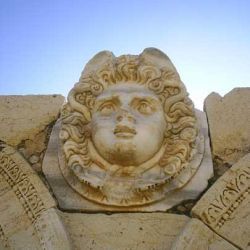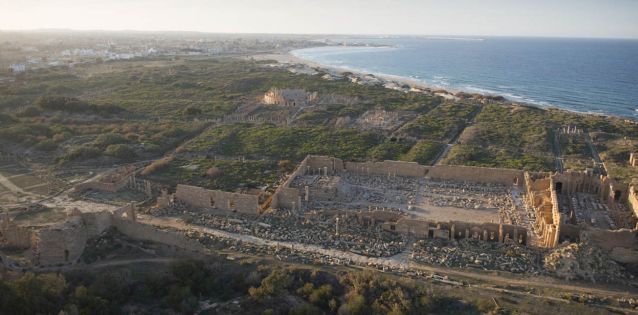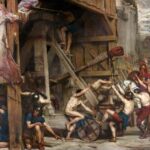Ancient Leptis Magna was initially a Phoenician city, then a Carthaginian city, and finally passed under Roman jurisdiction from the 1st century BCE. Important trading post in North Africa. The city, located close to the shore, served as a port, a place from which goods were transported to, among others, the port of Ostia and further to Rome. Both August, Hadrian and Septimius Severus were aware of this, taking care of the proper maintenance and development of the city; arose, among others Hadrian’s baths, theatre.
Emperor Severus, apart from being aware of the practical importance of this city for Rome, had a special fondness for this place because he was born there. He was the third emperor from the provinces of the Empire after Trajan and Hadrian. Therefore, the easier it was for him to decide on a place for his forum, for which there was no longer enough space in Rome (the last one was Trajan’s Forum).
Construction of the forum and basilica began around 209 CE and was completed in 216 CE by the son of Septimius – Caracalla. The location of the Forum is visible on the city map above. The place where I am was not chosen by chance – a collonaded street running from the port to the city centre (the forum and basilica adjoined it); a fountain that marked the junction of two streets. The plan behind the Forum and the Basilica resembles Trajan’s Forum.
The forum has an open, rectangular space, surrounded by columns, with the temple (no. 1 on the plan) situated next to its shorter wall, the free space in front of it (a method used by the Romans in much earlier buildings). The temple was erected by Caracalla to commemorate the gods Septimius Severus and Julia Domna, i.e. parents. It has a typical Roman character – a high podium (even as much as 5, 79 meters; it is a deliberate procedure to make the temple visible from a distance, reaching higher than the walls of the Forum), one room, single stairs leading to the atrium surrounded by free-standing columns. Local material was used to build its walls – lime. The columns in the vestibule were made of marble imported from Egypt (its feature is purple ).
It is believed that the column bases were decorated with scenes of battles between the Greek gods and the Titans. The temple was surrounded by an arcade of columns connected by arches, and between them, in free spaces, there were jellyfish heads.
The stairs, typical of a Roman temple, are also noteworthy, but they are made in a way reminiscent of those from Egyptian temples.
Rooms marked with 2 are tabernae, shops known for example at Caesar’s Forum. The shape of these stores is not a coincidence. Their wedge shape is related to the location of the Forum and the Basilica, and the need to fit in with the rest of the surroundings. The problem that the architects had to deal with was what people on the forum would see. The wedge shape of the shops was to mask the fact that the Forum and the Basilica were not in one straight line.
The basilica, marked No. 3 on the plan, was about 95 meters long and 35 meters wide. Two floors, a flat roof and coffered ceiling, a central nave, side aisles and apses on both sides, suggest that it is a building modelled on the plan of the Basilica of Trajan’s Ulpia. A characteristic feature of this building is two large columns in the Corinthian style with lintels and gryphons, made of Egyptian marble, located on the podium in the northern recess of the basilica (which may also indicate that court hearings were held there). At the same recess, there are pillars on which, among others, 12 works of Hercules. Local stone was used to build the walls of the Basilica – sandstone. The inscription on the architrave testifies that the construction was started by Septimius Severus and the work was completed during the reign of his successor, Emperor Caracalla.











